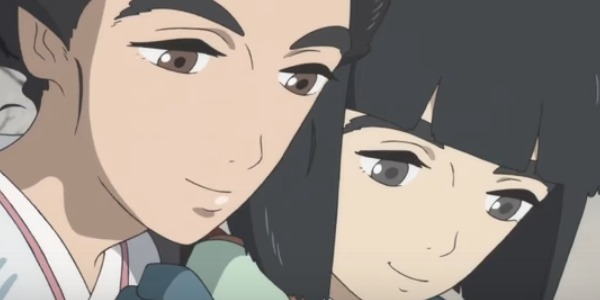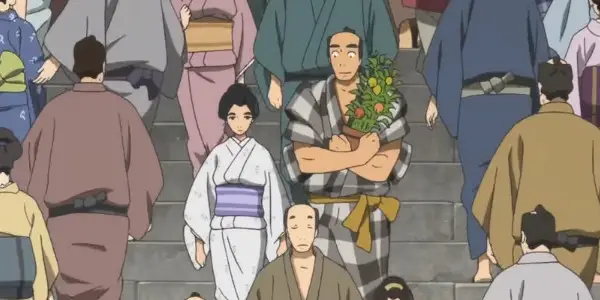MISS HOKUSAI: Images Of An Artist

Ben is a former student of cognitive science who is…
Very little changes in Miss Hokusai, and that’s okay. Though it contains recurring characters, a climax, and a subtle, implicit shift in the main character’s perspective, it doesn’t have forward momentum. You won’t stick with it because you absolutely must know what happens next. Sometimes it’s worth sticking with something just to be immersed.
That’s the essence of Miss Hokusai: the perspective of an artist immersed in details. For the painters who serve as its core characters, creating art is a kind of exchange, a way of resolving tensions. Their business involves sharing their own personal touches with each customer’s specified needs, and we get a sense for this when we see them wait for flashes of insight, seek out kindred spirits, and dwell on supernatural phenomena.
Image in the Waves
The titular “Miss Hokusai” is O-Ei Hokusai, the daughter of the renowned Japanese painter Katsushika Hokusai. Katsushika is the most famous historical figure to appear in the film, but there’s no question that it’s O-Ei’s story at its core. It’s all about understanding her behavior, and eventually, understanding her introspection through painting.

Sometimes we see O-Ei working with her blunt father and his easygoing students; then, O-Ei remains stoic and focused on work. When she’s escorting her blind sister Nao around town, trying to show her a good time, O-Ei is cheerful and generous, and devotes her creativity to finding something interesting to do. She can be awkward, but she’s also self-sufficient and constantly active.
O-Ei insists she can paint anything, but Katsushika insists that artists all have their own strengths and weaknesses. But even if O-Ei tends to think a little too quickly, Katsushika seems too passive for his own good. There’s tension between them and their ideas, but the film remains non-evaluative. The path it takes toward resolution considers these concepts only as drops in a sea of details that washes over O-Ei (and the audience) until she reaches a new level of fulfillment as an artist. They’re as important as the feel of the water in the river, the sound of merchants in the city, or the old woman selling tea in the snow.
Miss Hokusai offers us the essence of montage as described by Sergei M. Eisenstein, who believed montage was more than editing pictures together. For him, montage was forming images from representations – piecing particulars together and depicting changes over time to create something more than the sum of its parts.

The varied situations O-Ei encounters in her life are represented in Miss Hokusai as vignettes in which little details mount, from things as subtle as a character’s body language to things as striking as shifts in how the setting is rendered. They lend unexpected weight to the little visual grace notes that end them. New understanding suddenly hits the viewer from things as simple as O-Ei turning her face to reveal an ink stain on her cheek, or O-Ei and Katsushika walking by each other on the street and passing through a shaft of golden sunlight.
Developing Distinction
Of course, the building details are strong even without the moments of revelation they allow for. It’s remarkable just how intuitive they are. In one scene, O-Ei amuses Nao by bringing her to a bridge. There’s no dialogue, but from the sound design and a few judicious cuts, it’s perfectly clear that O-Ei and Nao have come not for the sights, but for the sounds and smells of the town’s midday bustle. Miss Hokusai‘s Edo is varied and dynamic, which only strengthens the character drama that takes place there.
As it happens, the film’s anachronistic music choices and brief intrusions of the supernatural serve that purpose in another way. O-Ei is an enthralling character not just for the distinction of her personality, but for the way her personality strikes the viewer in remarkably different ways depending on the situation.
She remains curt and stoic throughout the film, except for the moments when she shares sisterly smiles with Nao. When she’s with Katsushika and his crude, indecorous students, her bluntness seems like that of a person who’s slightly annoyed, but determined to persevere and handle the problems she knows won’t be handled by the people around her. When she’s with Nao, her straightforwardness and resilience make her seem like a mature, hyper-capable caretaker. And yet, when she’s working out the uncertainty of her love life, her reticence makes her seem immature – at once stubborn and unprepared.

O-Ei’s personality is consistent, but still lets her be an active participant in the Miss Hokusai‘s sense of variety; she’s both dynamic and perfectly distinct. And for that, the film makes it easy for the viewer to apprehend the experience of an idiosyncratic person. The aforementioned music and fantasy sequences serve the idea that the film is exposing the consequences her eccentricity has for her world and the people therein.
To Conclude
It’s difficult to say whether one part of Miss Hokusai is more important than any other part to the whole. It’s also unnecessary. The film’s climax – insofar as it can even be called that – isn’t a culmination of its narrative through-lines or a final statement on its themes; rather, it’s a moment of exchange between all the disparate aspects of O-Ei’s life.
And if we must decide that the film is ultimately in service of something, that exchange may as well be it. Because for all the film’s painters, art is a practice that involves synthesizing something from their lives and, consequently, broadening them. In their pursuit of art, finding their ways around the world becomes the same as finding their ways around their own potential.
What do you think of Miss Hokusai?
Miss Hokusai was released in the United States on October 14, 2016, and is still showing in limited release.
Does content like this matter to you?
Become a Member and support film journalism. Unlock access to all of Film Inquiry`s great articles. Join a community of like-minded readers who are passionate about cinema - get access to our private members Network, give back to independent filmmakers, and more.
Ben is a former student of cognitive science who is currently trying to improve his writing style and ability to understand and appreciate films containing unfamiliar perspectives. He tries not to hold films to a strict set of criteria, but does believe that strong movies can change your outlook on the world. His favorite films include Whisper of the Heart, Hellzapoppin', Foolish Wives, 42nd Street, and the work of Charlie Chaplin.













